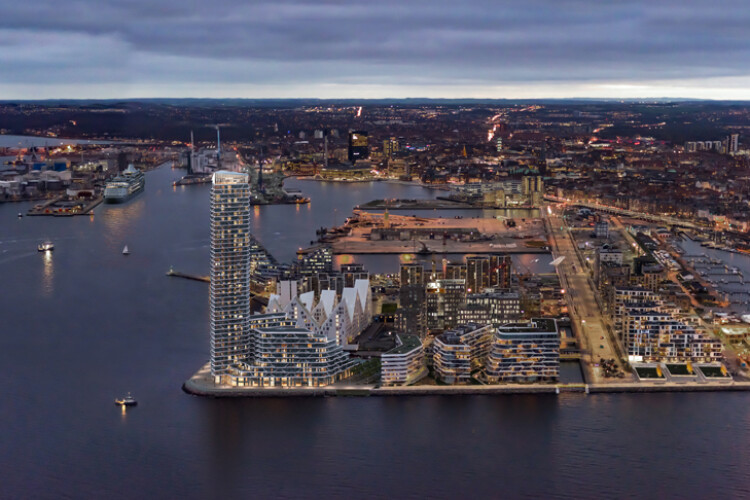It’s been dubbed Denmark’s tallest residential building, founded on the country’s worst ground conditions; no wonder they said it couldn’t be built. But now the 143m-tall tower that is the focus of the Lighthouse 2.0 development in Aarhus is finally coming out of the ground.
The project has a long and complex history – the first phase of the development started more than a decade ago but the challenge of high-rise construction on this particular site, and the impact of the global economic downturn, resulted in the second phase being shelved.
But now the 63,000m2 development is on track to be completed in 2022 and will see the creation of a new waterfront district built on land that was released by the relocation of the city’s port facilities.
This article was first published in the September 2020 issue of The Construction Index magazine. Sign up online.
The Lighthouse, designed by architect 3XN, will sit alongside other high-profile buildings such as Isbjerget (The Iceberg) and the city’s cultural centre Dokk1.
The position of the scheme, right at the end of a finger of land sticking out into the sea, was the catalyst for the ‘lighthouse’ concept. It was always intended that there would be a landmark development at this prominent site, and the tower would be flanked by two lower residential blocks – the promenade building and the canal building.
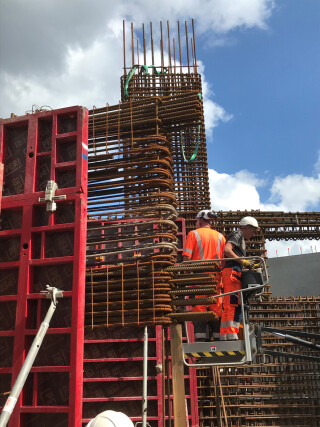
But concerns about the ground conditions raised question marks over the feasibility of a tall tower, and the original developer pulled out. Although the first phase was completed in 2012, the entire second phase, which proposed a hotel and commercial space as well as residential, was shelved due to the financial downturn.
In 2017 the scheme was revived with the appointment of a new developer, Kilden & Hindby, and a review of the phase two proposals. Residents who had bought in phase one and enjoyed unobstructed views for eight years were not happy at the prospect of losing the views and sunlight from their balconies. The initial concept for the tower was a shorter and wider structure than the one that is now under construction; a redesign saw the tower made higher but thinner, and the other buildings lowered.
Kilden & Hindby project manager Daniel Espensen explains that the cladding and balcony units have also been redesigned in aluminium, rather than the precast concrete that was used in the first phase, to save weight as well as to improve durability.
Reducing the weight of the structure was a key consideration, given the difficult ground conditions. While the 45-storey tower will be impressive, it represents just two thirds of the built structure; below ground the foundations extend to a depth of 70m, claimed to be the deepest production piles in Denmark.
Crucial to bringing the tower construction forward was the decision to install two full-size test piles to inform the final design and enable the capacity and characteristics of the ground to be more reliably assessed.
Turnkey contractor for the DKr1.18bn (£143m) contract is Aarsleff, and the company’s foundations project manager Ronny Lajer explains that the test piles were planned in collaboration with consultant Ramboll, to enable the results to be used for the detailed design of the tower.
The reclaimed land on which Aarhus 2.0 is located consists of a layer of around 10-12m of sand overlaying tertiary clay, described by Lajer as being “similar to London Clay but with worse characteristics” in that it has high plasticity, is more sensitive to fluctuations in moisture, has a lower bearing capacity and an increased potential for settlement. But despite low expectations, the test piles revealed a higher bearing capacity than predicted, lending confidence to the designers.
As well as proving that the tower could actually be built, the test results allowed the foundation design to be revised, Lajer says, and the number of piles that were needed was reduced.
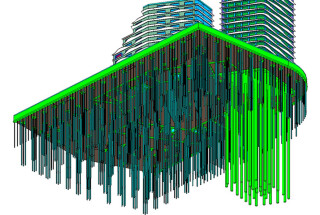
Different techniques were used to construct the two test piles – one was excavated using a crane and circular grab, the other was formed with full-depth steel casing – allowing Aarsleff to get a steer on which technique would best suit the ground conditions.
Lajer explains that steel casings were chosen, but critically they were not used to the full 70m depth of the tower piles. The test pile demonstrated that installing even 60mm-thick casings to full depth in this type of ground would potentially damage them and render them less effective. Instead the 2m-diameter piles under the tower were drilled using a Bauer BG55 drilling rig and a Bauer BV2000 oscillator, with 60mm-thick steel casing over the upper 20m of the pile, and the remaining 50m excavated under bentonite support. This applies to all 28 of the piles on which the tower is supported across its 25m x 25m footprint.
The substantial nature of the piles is indicated by the fact that the biggest drilling rig in Europe – and the second biggest in the world – was employed for their construction.
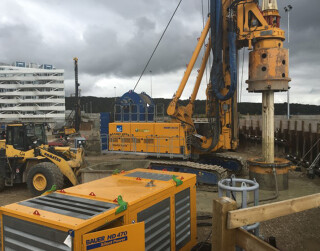
Three piles were opened at a time – the 25m high, 240-tonne machine would install casings for the first three piles and then start drilling the lower pile on each of them in turn. This was the most efficient solution, explains Lajer, as it enabled the rig to be kept working on one or other of the piles at all times. Although the clay has poor strength characteristics, and needs to be worked constantly to prevent it ‘freezing’, excavation did not require any special equipment to remove the approximately 220m3 of soil from each pile.

Bentonite was produced in a mixing plant located on the site and had to be tested regularly to ensure various characteristics relating to cleanliness and the level of suspended solids fell within the approved range.
Maintaining the cleanliness of the bentonite was one of a number of measures that the contractor used to safeguard the quality of the piles to maximise bearing capacity – desilting facilities on site enabled each batch to be cleaned for reuse several times over. After each pile was drilled to full depth, the bentonite was left to settle overnight then replaced with a clean batch, pumped in from the bottom up, before the rebar cages were lowered into place.
These cages were fixed in four sections, Lajer explains, due to the depth of the pile. Installation involved two crawler cranes with 80 tonnes and 100 tonnes capacity – one to support the lower cage section in the drilled hole and a second to suspend the subsequent section so welders could make the connections.
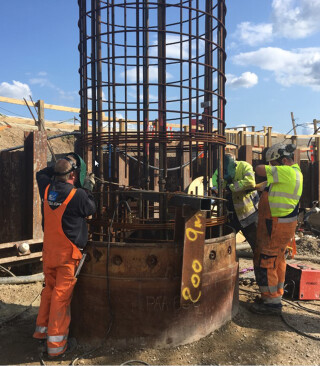
With rebar in place, and the quality of the bentonite checked one more time, a sonic caliper test was carried out before concreting to ensure that the pile met verticality requirements. Lajer recalls that the most extreme variation measured by the site team was just 180mm over the full 70m length, which was well within the allowable limits.
A high slump concrete mix was designed to survive the 70m journey to the bottom of the tremie pipe and enable it to flow around the rebar, which towards the top of the pile becomes increasingly dense. Workability of up to 12 hours was also a requirement: “Full casting of each pile took about four hours,” Lajer adds.
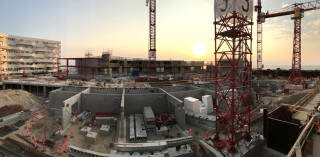
Final testing of each of the main piles took place some three weeks after concreting, with cross-hole sonic logging carried out across the full depth. A series of water tubes attached to the perimeter of the reinforcement cage allowed sensors to be lowered into the piles to detect any air holes, intrusion of surrounding material or other irregularities that might reduce the bearing capacity. Control measures clearly paid off, as every one of the piles passed the test and no reworking was necessary.
Piles of this size and type are rare in Denmark, confirms Lajer, and production required a great deal of optimisation in the use of the heavy machinery and crew. “We needed to have a good production rate to make it cost-effective,” he says. “We wanted to ensure that we were drilling all the time, not to have the equipment standing.” Other solutions were considered but this was the only one that could provide the necessary capacity in this type of ground. End bearing is low, so the design relies heavily on friction bearing.
Traditional concrete and steel piles, sheet piles and ground anchors were also included in the groundworks for the project to form foundations for the other two buildings and to create the two-storey below-ground car parks. “Everything has to be watertight, with construction going some 5m below the groundwater levels,” says Aarsleff project director Michael Kjӕr.
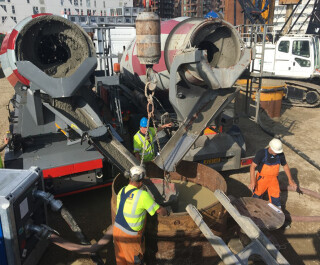
With foundations completed in February this year, construction of the three main buildings is moving on apace with Kjӕr’s team aiming to top out the promenade building and make it watertight by the end of this year.
The promenade and canal buildings, which are up to ten storeys – 45m – high, are being built using precast concrete elements, a very common construction process in Denmark. This is usually chosen for cost considerations, as well as speed, says Kjӕr. “Salaries are quite high in Denmark so in situ concreting is quite expensive by comparison.” Each type of element – columns, stairways, floor slabs and wall panels – comes from a different manufacturer, all less than 100km from the site, but there are complex logistics to address with ‘just in time’ delivery, given there is no space for storage.
By contrast, the concrete frame of the main tower is being built in situ due to the stiffness requirements and the need to restrict the sway of the structure. It is designed to move no more than 600mm at the top, under a 200-year return period wind event, he says.
Building in situ will be a challenge, Kjӕr predicts, with the high densities of reinforcement and the need to pump concrete to such heights under pressure demanding a very workable mix with a high compressive strength.
With its high cement content, concrete pours on the lower 30 floors of the building will require cooling to control the curing process. By the time construction reaches the 30th floor, the 800mm-thick structural elements that need this cooling will have been trimmed considerably; at the top level the same elements are only 200mm thick.
A self-climbing formwork system from Peri will be used for the tower construction, extending over four storeys and providing easy access for follow-on work behind the concrete pour. “One year from now, with our target rate of one floor per week, we intend to have completed all 44 floors,” Kjӕr says confidently.
The tower will be topped out by a restaurant facility which will incorporate an illuminated ‘crown’, intended to mimic the form and appearance of a lighthouse. But Espensen explains that the top level will also incorporate a viewing gallery to ensure that the vista of the city skyline from the country’s second highest building can be enjoyed by the general public, not just the paying diners.
This is still some time away – completion of the promenade building is planned for April 2022, with the tower and the canal building anticipated to follow in July of the same year.
This article was first published in the September 2020 issue of The Construction Index magazine. Sign up online.
Got a story? Email news@theconstructionindex.co.uk

